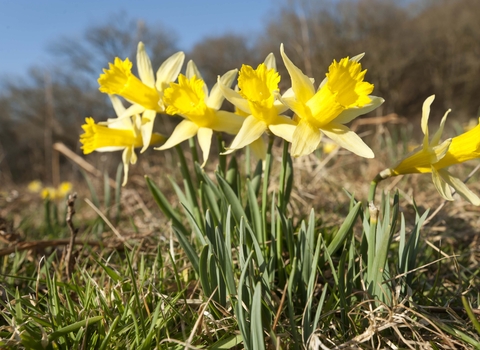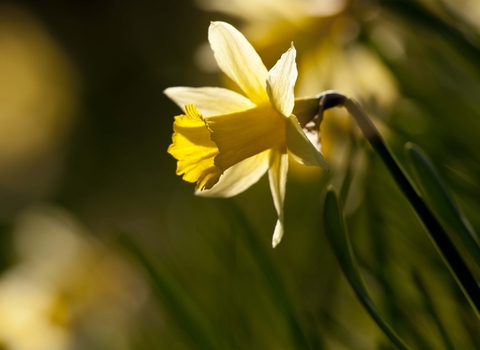
©Ross Hoddinott/2020VISION

©Ross Hoddinott/2020VISION
Wild daffodil
The bright yellow daffodils that adorn our roadsides and parks are likely to be garden varieties. Head to a woodland or damp meadow in North or South West England, or Wales, to see a true wild daffodil.
Scientific name
Narcissus pseudonarcissusWhen to see
March to AprilSpecies information
About
The yellow trumpets of daffodils brighten up the dullest spring day as they cluster together in gardens, on roadsides and in parks during March and April. But these are often the planted or escaped garden varieties. A real treat is spotting a Wild daffodil among the dappled shade of an ancient woodland, or pushing up through the grasses of a damp meadow. Once abundant and hand-picked for markets, this wildflower is now much rarer, having declined during the 19th century as a result of habitat loss. It can be seen in parts of south Devon, the Black Mountains in Wales, the Lake District in Cumbria, and along the Gloucestershire-Herefordshire border.How to identify
The wild daffodil has narrow, grey-green leaves and a familiar daffodil flower, but with pale yellow petals surrounding a darker yellow trumpet; this two-tone look is one way to tell them apart from their garden relatives. The wild daffodil is also relatively short and forms clumps, carpeting the ground.Distribution
Found throughout mainland UK.In our area
In Montgomeryshire, the Wild Daffodil has an eastern distribution and grows naturally in old grassland and open woodland. It can also be seen on road verges, in gardens and churchyards, where it is thought to have been planted. Sadly, the Wild Daffodil has become uncommon in Montgomeryshire; any natural sites should be cherished.
Did you know?
Also commonly known as the 'Lent lily' for its long association with Easter celebrations, the wild daffodil got its Latin name, Narcissus, from an Ancient Greek myth. Narcissus fell in love with his own reflection in a pool of water, becoming so obsessed that he fell in and drowned. The nodding head of the wild daffodil embodies Narcissus bending over the water and it's said that the first flower sprang from where he died.In Montgomeryshire, the Wild Daffodil has an eastern distribution and grows naturally in old grassland and open woodland. It can also be seen on road verges, in gardens and churchyards, where it is thought to have been planted. Sadly, the Wild Daffodil has become uncommon in Montgomeryshire; any natural sites should be cherished.
